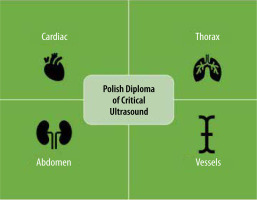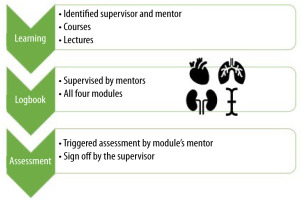Ultrasonography (US) is now an important component of the assessment of critically ill patients [1–5]. Over the past decade, there has been continual improvement in US technology and greater clinical implementation [4] alongside more structured training for practitioners. Indeed, several accreditation pathways are now available specifically for critically ill patients [6, 7]. In parallel, there is a growing body of scientific evidence supporting the use of multi-modal, point-of-care ultrasound (POCUS) in the assessment, diagnostics, and procedural aspects of managing patients [3, 8–20].
In 2020, the Joint Commission on Accreditation of Healthcare Organizations and the Emergency Care Research Institute recognised the implementation of POCUS without the necessary safeguards as a major health risk [4]. These include the provision of a structured way for acquiring competencies and evaluation of skills to ensure safe practice.
The European Society of Intensive Care Medicine (ESICM) recognised the need to include POCUS as an essential competency for the European Intensive Care Medicine (ICM) specialist. In 2022, they updated Competency Based Training in Intensive Care (CoBaTrICe) and proposed the minimum standard of knowledge, skills, and attitudes required for a doctor to be identified as a specialist in ICM in Europe [21].
The aim of the Polish Society of Anaesthesiology and Intensive Therapy (PTAiIT) Ultrasound and Echocardiography Committee (UEC) recommendations is to:
define essential POCUS competencies for anaesthesia and intensive care specialists and trainees in Poland,
propose an accreditation process for POCUS training,
outline evaluation of competencies.
RECOMMENDATIONS
UEC recommendations are based on the current scientific evidence and international guidelines for the general ICM population:
Competency Based Training in Intensive Care (CoBaTrICe) [21],
ESICM: Basic ultrasound head-to-toe skills for intensivists in the general and neurointensive care unit population [5],
ESICM: Recommendations for core critical care ultrasound competencies as a part of specialist training in multidisciplinary intensive care: a framework proposed by the European Society of Intensive Care Medicine [22].
DISCREPANCIES
The 2021 ESICM consensus and expert recommendations produce one statement recommending the use of transcranial color-coded duplex (TCCD) insonation of the middle cerebral artery as a basic skill for qualitative waveform analysis and to measure the pulsatility index to rule out intracranial hypertension impairing cerebral perfusion (weak recommendation). UEC recognised the utility of TCCD and diaphragmatic ultrasound and will re-evaluate the feasibility of inclusion in the basic competencies in the Polish accreditation programme.
POLISH DIPLOMA OF CRITICAL ULTRASOUND
The essential POCUS competencies for anaesthesiology and intensive care specialists and trainees in Poland are defined as the Polish Diploma of Critical Ultrasound (PDCU).
The PDCU consists of four domains (cardiac, thorax, abdomen, and blood vessels) and each domain has defined ultrasound signs that candidates must be able to recognise (Table 1).
TABLE 1
Basic competencies in the Polish Diploma of Critical Ultrasound (PDCU)
MODULAR STRUCTURE
To accommodate different educational and skillset needs, a structured pathway for accreditation in POCUS was created. The core competencies are included in the PDCU and consist of basic US in cardiac, chest, abdomen, and blood vessels. Developing competencies in all four domains is required for the certification with PDCU (Figure 1). Essential competencies for the use of ultrasound devices are defined in Table 2.
TABLE 2
Essential competencies for the use of ultrasound devices
ACCREDITATION PROCESS
For the PDCU, candidates should undertake a structured process of acquiring competencies by learning, practising, and evaluating.
The entry criteria for the certification process are:
be a specialist or trainee in recognised specialties,
attend an ultrasound course recognised by the UEC and have an identified mentor.
After acceptance for the certification process, candidates will have to collect a logbook consisting of cases in cardiac, thorax, abdominal, and vascular ultrasound. On completion of a logbook, candidates’ competencies will be signed off by the supervisor and mentor (Figure 2).
SUPERVISORS AND MENTORS
The role of a supervisor is to oversee the accreditation process as a whole: logbook co-signing with a mentor, and competency assessment. Supervisors will be appointed by the UEC.
Mentors are responsible for supporting trainees locally to obtain competencies in each domain. Mentors should be chosen from the same institution as a trainee to allow for hands-on training and regular feedback. A mentor could be any physician with PDCU or recognised ultrasound competencies as a part of the specialty training. There could be a different mentor for each domain.
The role of mentors is to:






